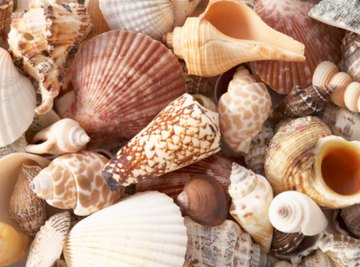
The East Coast of the United States is home to thousands of species of mollusks. These mollusks have shells that often wash up on beaches along the Atlantic Ocean. While a random group of shells makes an attractive display, your hobby can become more interesting if you take time to identify the kinds of shells in your collection. The shells you find are most likely to come from a few dozen species. However, as you sort through your shells and systematically divide them by general type, you may find some seashells that are quite unusual.
- Soft brush
- Guidebook to shells
- Magnifying glass
- Metric ruler
If you can’t find an exact match, try posting a picture of your shell online on a conchology identification forum, or take the shell to a Atlantic coast nature museum or wildlife park and show it to an expert.
Record the location and the type of shore where a particular shell was found. Note whether it was sandy, rocky or pebbly and what kind of vegetation, if any, was growing in the shallow water close to the shore.
Wash your shells. Use a soft brush to remove grime. Dust and dirt can obscure features of the seashell. Wet shells show the colors they have underwater, which can help when comparing your Atlantic seashells to pictures in a shell guidebook.
Look at the general shape of each shell, and sort them into groups. There are two main groups of shelled mollusks: bivalves and gastropods. Bivalves have two rounded sections joined together with a hinge, although you might find the sections separately. Common bivalves of the Atlantic coast are mussels, clams, cockles, oysters and scallops. Gastropods usually have coiled or conical shells. Examples include whelks, periwinkles, limpets and slipper snails.
Examine the exact shape of each shell. It might be tusk-shaped, cone-shaped or snail-shaped. The shape should narrow the possibilities down to a few families.
Measure the shell. Although the shells of mollusks grow as the animals grow, each species has a maximum and minimum size. Measuring the length and width will eliminate species that are too big or too small.
Note the colors, patterns and textures on your seashells. Some species, such as the angulate wentletrap, have very distinctive, ornate ribbing. Others have knobs, spikes or bumps. Use a magnifying glass to examine the shell closely.
Compare the characteristics of your shell to the ones listed in the seashell guidebook to narrow down the possibilities. Your notes on location and habitat will also help determine the species, because most guidebooks will include information on the environment in which a species is most often found.
Things You'll Need
Tips
References
Resources
Tips
- If you can't find an exact match, try posting a picture of your shell online on a conchology identification forum, or take the shell to a Atlantic coast nature museum or wildlife park and show it to an expert.
About the Author
Judith Willson has been writing since 2009, specializing in environmental and scientific topics. She has written content for school websites and worked for a Glasgow newspaper. Willson has a Master of Arts in English from the University of Aberdeen, Scotland.
Photo Credits
BananaStock/BananaStock/Getty Images
